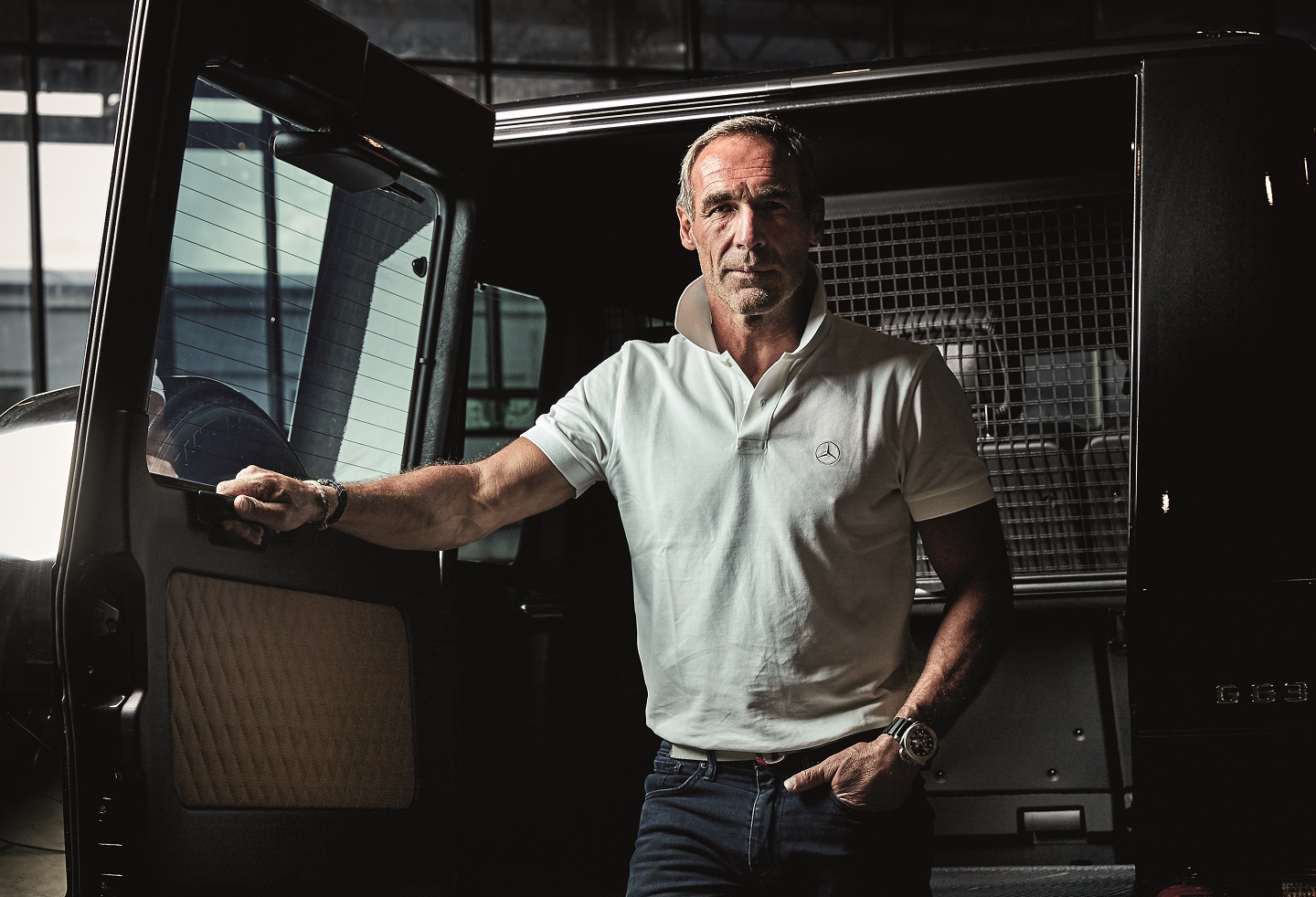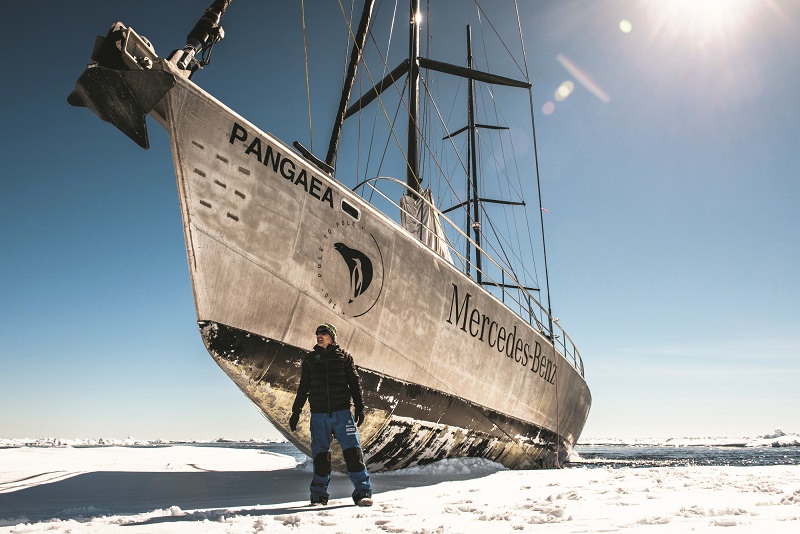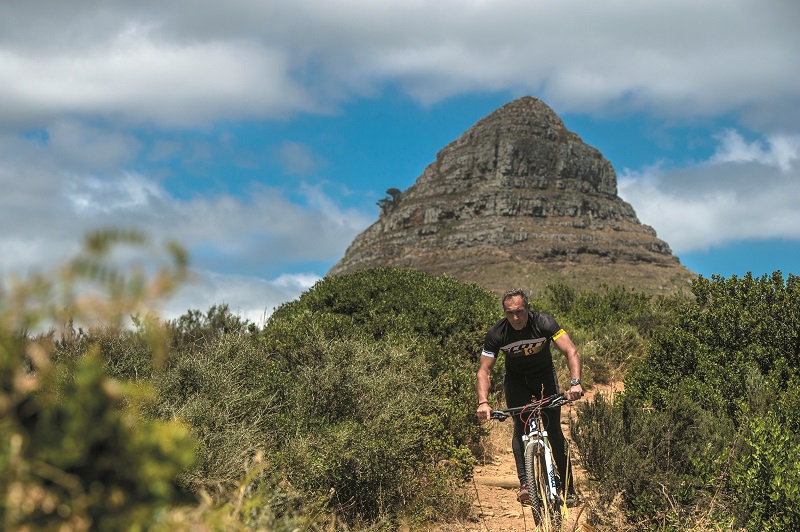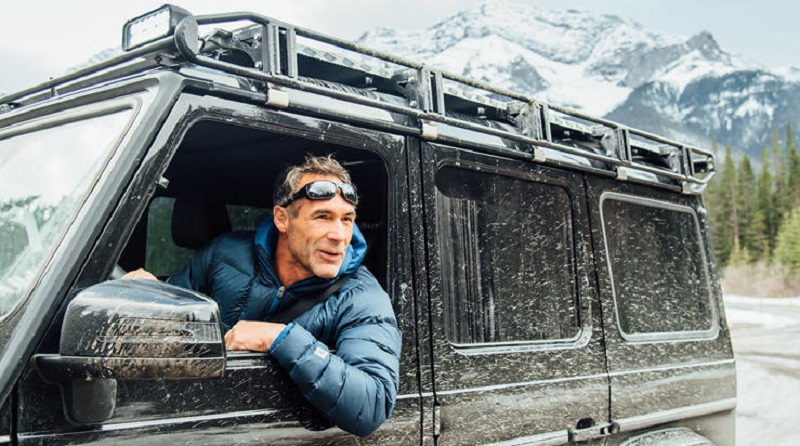
(Photography by SooPhye)
When I arrive at the EX8 event space in Subang Jaya, Selangor, for my interview with Mike Horn, he is about an hour deep into his session with the luxury German carmaker Mercedes-Benz’s specially curated audience of partners and friends. It is 2pm, after a nice lunch, and yet the small crowd is thoroughly engrossed. Horn speaks in engaging tones, urgent and imploring, about strength and perseverance — his messages aren’t unheard of or outstanding, but he delivers them well.
A native of South Africa, whose accent is toned down by many years of living in Switzerland, Horn is known for his famously challenging expeditions in some of the world’s most adverse conditions. They include traversing the Amazon from source to mouth solo, circumnavigating the Arctic Circle alone and sailing to all of the Earth’s continents under the four-year Pangaea Project. Much of Horn’s initial travels were self-funded and the amazing levels of self-discipline the expeditions required have earned him admission to The Explorers Club in New York, whose members are leading explorers of land, sea, air and space.
The Pangaea Project took place in 2008, when Horn launched his own sustainability programme and invited adolescents from around the world to join him on individual legs of the resulting sailing expedition, on board a vessel also named Pangaea. Horn’s goal was simple: To show his young crew the beauty of the world around us and the threats it faces here and now. Swiss watchmaker Officine Panerai stepped in as sponsor, and he wears the watch resulting from that partnership even today. Mercedes-Benz is also a long-term partner of Horn’s, as his ideals of environmental conservation are similar to the carmaker’s.
Horn was approached by the Stuttgart-born marque after winning the Laureus World Alternative Sportsperson of the Year Award in 2001. “They said they were really touched by what I said and did — this was after I circumnavigated the world along the equator — and they wanted to use some of my philosophies as part of their brand values. They also asked if I wanted to drive a Mercedes-Benz vehicle. At that point, early in my career, I only had a bicycle and was doing stuff that wasn’t making much money. To have a partner that’s bigger than you, yet is so trusting of what you do — I was very grateful. I was also very, very excited,” he laughs, the corners of his brown eyes crinkling merrily.

Horn’s pledge to conquer K2, the world’s second-highest peak, came next. The daring sportsman set off from his home in Switzerland in mid-May 2015 for the first part of his adventure. Challenge No 1: Drive all the way to Pakistan, home of K2, which required him to travel overland through 10 countries in a G-Class, Mercedes-Benz’s high-performance off-road vehicle that Mike calls “the motorised version of me”. Unfortunately, he failed to reach the finishing line at K2’s peak because of punishing weather conditions, but took away an important lesson from that experience: You have to know when to back down from a challenge.
The G-Class that he has is a standard issue car from Mercedes-Benz’s production line, including leather-panelled seats, but is fitted with additional fuel tanks for Horn’s specific needs. “We have a luxury exploration vehicle, which is great,” he says with a mischievous grin. “I sleep in a tent, on the ground, 80% of the time, so the moment I can score a bit of luxury when I am on the road, I go straight for it — I deserve this. What’s most important is what’s under the hood anyway, and I really think that if I had to go out and buy a car for what I need to do, I would get the G-Class.”
Pole2Pole is the expedition he is on now, and his most ambitious to date. On May 6 last year, Horn sailed from Monaco to Namibia aboard Pangaea, and continued on land in the G-Class through the world’s oldest desert, the Namib, on the Namibian coast. The route then passed through the Okavango delta in Botswana and on to Cape Town. From there, Pangaea took him to the Antarctic, which he crossed on skis. After sailing the Pacific through the islands of Oceania to Asia — which includes his Malaysian pit stop — Horn will explore parts of New Zealand and Australia.
In Papua New Guinea, the G-Class awaits him for an expedition through unspoilt equatorial forests. A further overland expedition in Mercedes-Benz’s legendary off-road vehicle will lead Horn through the tundra in Kamchatka before he makes his way to the North Pole. The extreme athlete will then cross the Arctic and proceed to Greenland on skis and in a kayak. He will then sail from the world’s largest island back to Monaco aboard Pangaea.
“This was my opportunity to combine everything I’ve learnt in a single project. With Pole2Pole, I took 25 years of experience and put it in a shaker to see if I could cross both poles, climb mountains, cross deserts, sail across oceans and mix everything I’ve learnt into one expedition. Sailing to Antarctica has never been done before, so everything is a learning experience and the daily unknown is a driving force for me. After a while of that, it’s nice to do something familiar, something you know. So sailing, especially back to Malaysia, has been wonderful,” he admits.
After putting away a great deal of calorie-dense foods — taste ticklers such as solid cubes of olive oil, for example — to cope with the cold in the Antartic, Horn is thoroughly enjoying his time in warm and sunny Malaysia, indulging in as much local fare as he can. Indian food and chicken rice emerge as frontrunners, I am amused to find out. “I love Malaysia, it softly introduces Asia to you,” he says thoughtfully. “It’s so multicultural here, which really reminds me of home. And I do love the environmental landscape, which I am able to explore at length with the boat. This is such a great base [from which] to wander around the Southeast Asian archipelago as well.”
There are parts of this region he has never quite explored before, so Pole2Pole has really been an eye-opener. Ocean conservation is a major thrust of his activities during his travels, and he is excited about contributing to the existing bank of knowledge relating to ocean health and global warming. What is also important to Horn is the way this expedition, more than his previous ones, has been documented on social media and tracked by thousands, specifically those from a younger age group. Horn hopes these impressionable young people will be inspired by the images of nature he brings to their lives and, in that way, be compelled to make a difference.

“I assumed that as I was getting older, the demographic of people following me on social media would be older as well. But for some reason, the bulk of my followers are much younger — 25 to about 38 years old. They are quite equally split between male and female. I think it’s wonderful. The biggest source of energy we have isn’t coal power or nuclear plants. It’s the younger generation! We have uncut diamonds out there who we don’t listen to because we think we know it all. We need to empower younger people with knowledge and responsibilities… I listen to my daughters, and I realise that we old fogies need to stop thinking we can do it all.”
***
In a one-on-one setting, Horn is a gentler version of the man on stage who delivers passionate performances centred on his travels as he unveils the astounding pictures he has captured of them. Lounging on a leather couch, talking about his late wife Cathy and daughters Annika and Jessica, Horn lets his guard down and I see the man beyond the explorer. He is kind and gentle, with an easy smile that reaches his eyes.
He gets a little wistful talking about how he met Cathy and the circumstances surrounding her passing in 2015, but tells the story in a refreshingly honest and down-to-earth way. His two daughters — “they are as beautiful as their mother,” he gushes touchingly — are his anchors now, and feature heavily in his travels based on their own interest in what he does. “We had a map at home and as children they used to track my travels all the time. They would know exactly what I was seeing, and they lived so much of my travels with me,” he recalls.
The biggest source of energy we have isn’t coal power or nuclear plants. It’s the younger generation! We have uncut diamonds out there who we don’t listen to because we think we know it all. We need to empower younger people with knowledge and responsibilities
Horn met Cathy in Switzerland, the first country he could get an air ticket to when he decided life in apartheid-era South Africa was simply not working out the way he had hoped. Disenchanted and craving meaning, Horn arrived in Europe and was working as a ski instructor when he met Cathy. Eventually, he made Lausanne his home. He was 28 at the time, and had finished an assignment with the South African Special Forces Brigade. “I had done well and realised I was collecting the wrong things — I had the car, the house, the money, but no relationships. So I thought I’d reset my life by giving all my stuff away and search for actual meaning.”
It takes a lot of inner strength to make such a major decision, but Horn’s upbringing had gifted him this. His parents, Horn recalls, always let their three children revel in their own interests and develop their own personalities. As a child, Horn was obsessed with birds and animals and was encouraged to explore the outdoors, while his sisters were given the space to pursue their own dreams — one became a lawyer and judge, and the other, an artist.
Horn’s wife became his best friend and the greatest supporter of his expeditions, giving him roots so his dreams could continue to take flight. “I always said I’d die for her, and she’d say, ‘No, don’t. Live for me, and I will see you soon’. We spent 25 years together, so I was never sad about what we didn’t have, only happy for the time we had. I could do all that I did because I had her support,” he says tenderly.
“We worked on Pole2Pole together, and I couldn’t do it once she died. But my daughters came to me and said, ‘You planned to do this, so do it in her honour. We will let you go, because not doing this is killing you inside.’ People may wonder why a widower with two daughters even wants to cross the Antartic, but they don’t know the dynamics that made it possible — my girls letting me go, the boat I had, the weather, the existing knowledge that made it possible … All the stars were aligned for this to happen, which is why it did.”

His daughters have taken on their mother’s role of being Horn’s greatest cheerleader, and also help him with the business side of things. As he jokingly puts it, “I do lots of great stuff but not all of them make much money”. Outside of exploring, Horn is a bit of a television star in Europe — he is the survival expert on the The Island: Seuls au monde, and also stars in À l’état sauvage, the French version of American TV show Running Wild with Bear Grylls. His motivational coaching projects have also borne fruit: The cricket teams of India and South Africa both scored huge wins after a session with Horn, as did the German football team, which won the FIFA World Cup in 2014 after 24 years.
“The big thing with my kids is that we are together without being together,” he says, smiling proudly. “They work for me, so we talk about business opportunities very often. When we talk on the phone, it’s about work stuff. But when they come and see me, it’s about being together on holiday. So we are on the boat, and we explore together. When I tap into their world, its business, but when they come to my world, its holiday.”
And while expeditions are hard work as they simultaneously test the mind, body and spirit, there is still great enjoyment to be had. We hear that Horn fancies the occasional whisky, and especially enjoys it on the rocks with ice from the poles that are likely older than the whiskies themselves. He laughs heartily when I ask him about this. “Single malt whiskies are always the best kind, and what I have with me on any particular occasion depends on what I was given. It doesn’t even matter where it’s from, because single malts are made with so much love and dedication. And when you add ice that’s even older than the whiskies … the oxygen that’s been captured in the ice for millions of years and is now in my whisky ... I think even the thought process is most exciting,” he grins.
Our hour-long chat has come to an end, and if not for the thought of the punishing traffic on a rainy Friday afternoon, I would have kept going. I ask Horn if he has any last thoughts, and he does not disappoint. “I am not made for the world of celebrities, I am just an explorer,” he says, glancing at the pattering rain outside. “I love the freedom I get on mountains or on the ice, and that is what makes me tick. I don’t think I can ever become a celebrity because I don’t know how to deal with it. You must want to want it. All I want are my daughters, and to never stop exploring. I hope to always be remembered for what I gave to the world, not what I took from it.”
This cover story appeared in the Jan 8, 2018 issue of The Edge Malaysia. Save by subscribing to us for your print and/or digital copy.


